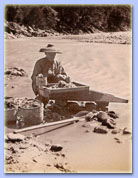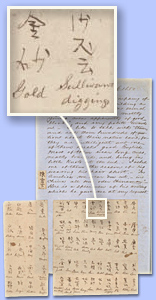


TOP: Cradle
[Chinese man mining along river]
BOTTOM & DETAIL:
Timothy Coffin Osborn journal
While the west coast of North America was known to the Chinese, in particular those working as sailors, before the Gold Rush, our story begins in 1850, as the documentation from the Gold Rush provides the starting point with which to build a more substantial narrative. Most Chinese immigrants entered California through the port of San Francisco. From San Francisco and other ports, many sought their fortunes in other parts of California. The Chinese formed part of the diverse gathering of peoples from throughout the world who contributed to the economic and population explosion that characterized the early history of the state of California. The Chinese who emigrated to the United States at this time were part of a larger exodus from southeast China searching for better economic opportunities and fleeing a situation of political corruption and decline. Most immigrants came from the Pearl River Delta in Guangdong (Canton) Province.
Chinese immigrants proved to be productive and resourceful contributors to a multitude of industries and businesses. The initial group of Chinese argonauts sought their livelihood in the gold mines, calling California Gam Saan or Gold Mountain. For the mining industry, they built many of the flumes and roads, allowing for easier access and processing of the minerals being extracted. Chinese immigrants faced discrimination immediately upon arrival in California. In mining, they were forced to work older claims, or to work for others. In the 1850s, the United States Constitution reserved the right of naturalization for white immigrants to this country. Thus, Chinese immigrants lived at the whim of local governments with some allowed to become naturalized citizens, but most not. Without this right, it was difficult to pursue livelihoods. For example, Chinese immigrants were unable to own land or file mining claims. Also in the 1850s, the California legislature passed a law taxing all foreign miners. Although stated in general terms, it was enforced chiefly against the Mexicans and the Chinese through 1870. This discrimination occurred in spite of the fact that the Chinese often contributed the crucial labor necessary to the mining enterprise.
Discriminatory legislation forced many Chinese out of the gold fields and into low-paying, menial, and often arduous jobs. In many cases, they took on the most dangerous and least desirable components of work available. They worked on reclaiming marshes in the Central Valley so that the land could become agriculturally productive. They built the stone bridges and fences, constructed roads, and excavated storage areas for the wine industry in Napa and Sonoma counties. The most impressive construction feat of Chinese Americans was their work on the western section of the transcontinental railroad. Chinese-American workers laid much of the tracks for the Central Pacific Railroad through the foothills and over the high Sierra Nevada, much of which involved hazardous work with explosives to tunnel through the hills. Their speed, dexterity, and outright perseverance, often in brutally cold temperatures and heavy snow through two record breaking winters, is a testimony to their outstanding achievements and contributions to opening up the West.